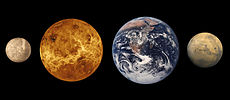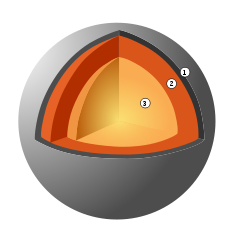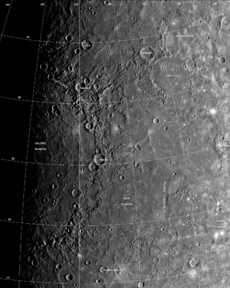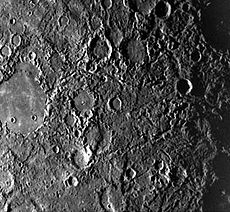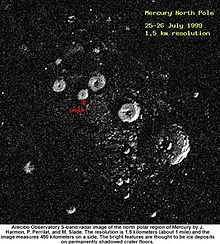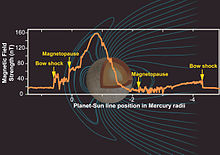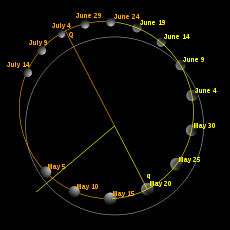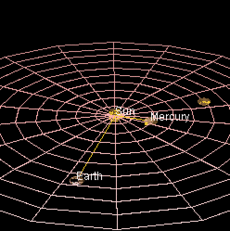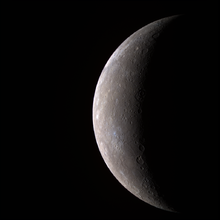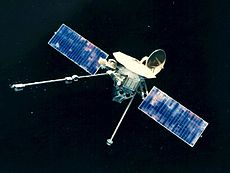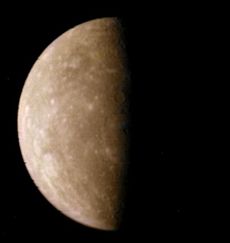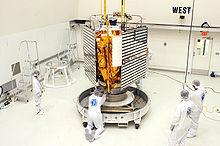- Mercury (planet)
-
Mercury ☿ 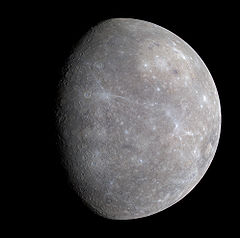 Designations
DesignationsPronunciation  i/ˈmɜrkjəri/
i/ˈmɜrkjəri/Adjective Mercurian, Mercurial[1] Epoch J2000 Aphelion 69,816,900 km
0.466 697 AUPerihelion 46,001,200 km
0.307 499 AUSemi-major axis 57,909,100 km
0.387 098 AUEccentricity 0.205 630[3] Orbital period 87.969 1 d
(0.240 846 a)
0.5 Mercury solar daySynodic period 115.88 d[3] Average orbital speed 47.87 km/s[3] Mean anomaly 174.796° Inclination 7.005° to Ecliptic
3.38° to Sun’s equator
6.34° to Invariable plane[4]Longitude of ascending node 48.331° Argument of perihelion 29.124° Satellites None Physical characteristicsMean radius 2,439.7 ± 1.0 km[5][6]
0.3829 EarthsFlattening 0[6] Surface area 7.48×107 km2[5]
0.147 EarthsVolume 6.083×1010 km3[5]
0.056 EarthsMass 3.3022×1023 kg[5]
0.055 EarthsMean density 5.427 g/cm3[5] Equatorial surface gravity 3.7 m/s2
0.38 g[5]Escape velocity 4.25 km/s[5] Sidereal rotation
period58.646 day
1407.5 h[5]Equatorial rotation velocity 10.892 km/h (3.026 m/s) Axial tilt 2.11′ ± 0.1′[7] North pole right ascension 18 h 44 min 2 s
281.01°[3]North pole declination 61.45°[3] Albedo 0.068 (Bond)[8]
0.142 (geom.)[8]Surface temp.
0°N, 0°W
85°N, 0°Wmin mean max 100 K 340 K 700 K 80 K 200 K 380 K Apparent magnitude −2.6[9] to 5.7[3][10] Angular diameter 4.5" – 13"[3] Atmosphere[3]Surface pressure trace Composition 42% Molecular oxygen
29.0% sodium
22.0% hydrogen
6.0% helium
0.5% potassium
Trace amounts of argon, nitrogen, carbon dioxide, water vapor, xenon, krypton and neonMercury is the innermost and smallest planet in the Solar System,[a] orbiting the Sun once every 87.969 Earth days. The orbit of Mercury has the highest eccentricity of all the Solar System planets, and it has the smallest axial tilt. It completes three rotations about its axis for every two orbits. The perihelion of Mercury's orbit precesses around the Sun at an excess of 43 arcseconds per century, a phenomenon that was explained in the 20th century by Albert Einstein's General Theory of Relativity.[11] Mercury is bright when viewed from Earth, ranging from −2.3 to 5.7 in apparent magnitude, but is not easily seen as its greatest angular separation from the Sun is only 28.3°. Since Mercury is normally lost in the glare of the Sun, unless there is a solar eclipse it can be viewed from Earth's Northern Hemisphere only in morning or evening twilight, while its extreme elongations occur in declinations south of the celestial equator, such that it can be seen at favorable apparitions from moderate latitudes in the Southern Hemisphere in a fully dark sky.
Comparatively little is known about Mercury; ground-based telescopes reveal only an illuminated crescent with limited detail. The first of two spacecraft to visit the planet was Mariner 10, which mapped about 45% of the planet’s surface from 1974 to 1975. The second is the MESSENGER spacecraft, which attained orbit around Mercury on March 17, 2011,[12] to map the rest of the planet.[13]
Mercury is similar in appearance to the Moon: it is heavily cratered with regions of smooth plains, has no natural satellites and no substantial atmosphere. Unlike the Moon, it has a large iron core, which generates a magnetic field about 1% as strong as that of the Earth.[14] It is an exceptionally dense planet due to the large relative size of its core. Surface temperatures range from about 90 to 700 K (−183 °C to 427 °C),[15] with the subsolar point being the hottest and the bottoms of craters near the poles being the coldest.
Recorded observations of Mercury date back to at least the first millennium BC. Before the 4th century BC, Greek astronomers believed the planet to be two separate objects: one visible only at sunrise, which they called Apollo; the other visible only at sunset, which they called Hermes.[16] The English name for the planet comes from the Romans, who named it after the Roman god Mercury, which they equated with the Greek Hermes (Ἑρμῆς). The astronomical symbol for Mercury is a stylized version of Hermes' caduceus.[17]
Contents
Internal structure
Mercury is one of four terrestrial planets in the Solar System, and is a rocky body like the Earth. It is the smallest planet in the Solar System, with an equatorial radius of 2,439.7 km.[3] Mercury is even smaller—albeit more massive—than the largest natural satellites in the Solar System, Ganymede and Titan. Mercury consists of approximately 70% metallic and 30% silicate material.[18] Mercury's density is the second highest in the Solar System at 5.427 g/cm3, only slightly less than Earth’s density of 5.515 g/cm3.[3] If the effect of gravitational compression were to be factored out, the materials of which Mercury is made would be denser, with an uncompressed density of 5.3 g/cm3 versus Earth’s 4.4 g/cm3.[19]
Mercury’s density can be used to infer details of its inner structure. While the Earth’s high density results appreciably from gravitational compression, particularly at the core, Mercury is much smaller and its inner regions are not nearly as strongly compressed. Therefore, for it to have such a high density, its core must be large and rich in iron.[20]
Geologists estimate that Mercury’s core occupies about 42% of its volume; for Earth this proportion is 17%. Recent research strongly suggests Mercury has a molten core.[21][22] Surrounding the core is a 500–700 km mantle consisting of silicates.[23][24] Based on data from the Mariner 10 mission and Earth-based observation, Mercury’s crust is believed to be 100–300 km thick.[25] One distinctive feature of Mercury’s surface is the presence of numerous narrow ridges, extending up to several hundred kilometers in length. It is believed that these were formed as Mercury’s core and mantle cooled and contracted at a time when the crust had already solidified.[26]
Mercury's core has a higher iron content than that of any other major planet in the Solar System, and several theories have been proposed to explain this. The most widely accepted theory is that Mercury originally had a metal-silicate ratio similar to common chondrite meteorites, thought to be typical of the Solar System's rocky matter, and a mass approximately 2.25 times its current mass.[27] Early in the Solar System’s history, Mercury may have been struck by a planetesimal of approximately 1/6 that mass and several hundred kilometers across.[27] The impact would have stripped away much of the original crust and mantle, leaving the core behind as a relatively major component.[27] A similar process, known as the giant impact hypothesis, has been proposed to explain the formation of Earth’s Moon.[27]
Alternatively, Mercury may have formed from the solar nebula before the Sun's energy output had stabilized. The planet would initially have had twice its present mass, but as the protosun contracted, temperatures near Mercury could have been between 2,500 and 3,500 K (Celsius equivalents about 273 degrees less), and possibly even as high as 10,000 K.[28] Much of Mercury’s surface rock could have been vaporized at such temperatures, forming an atmosphere of "rock vapor" which could have been carried away by the solar wind.[28]
A third hypothesis proposes that the solar nebula caused drag on the particles from which Mercury was accreting, which meant that lighter particles were lost from the accreting material.[29] Each hypothesis predicts a different surface composition, and two upcoming space missions, MESSENGER and BepiColombo, both aim to make observations to test them.[30][31]
Surface geology
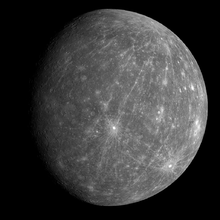 Image from MESSENGER's second Mercury flyby. Kuiper crater is just below center. An extensive ray system emanates from Hokusai crater near the top.
Image from MESSENGER's second Mercury flyby. Kuiper crater is just below center. An extensive ray system emanates from Hokusai crater near the top.
Mercury’s surface is overall very similar in appearance to that of the Moon, showing extensive mare-like plains and heavy cratering, indicating that it has been geologically inactive for billions of years. Since our knowledge of Mercury's geology has been based on the 1975 Mariner flyby and terrestrial observations, it is the least understood of the terrestrial planets.[22] As data from the recent MESSENGER flyby is processed this knowledge will increase. For example, an unusual crater with radiating troughs has been discovered which scientists called "the spider."[32] It later received the name Apollodorus.
Names for features on Mercury come from a variety of sources. Names coming from people are limited to the deceased. Craters are named for artists, musicians, painters, and authors who have made outstanding or fundamental contributions to their field. Ridges, or dorsa, are named for scientists who have contributed to the study of Mercury. Depressions or fossae are named for works of architecture. Montes are named for the word "hot" in a variety of languages. Plains or planitiae are named for Mercury in various languages. Scarps[disambiguation needed
 ] or rupēs are named for ships of scientific expeditions. Valleys or valles are named for radio telescope facilities.[33]
] or rupēs are named for ships of scientific expeditions. Valleys or valles are named for radio telescope facilities.[33]Albedo features refer to areas of markedly different reflectivity, as seen by telescopic observation. Mercury possesses Dorsa (also called "wrinkle-ridges"), Moon-like highlands, Montes (mountains), Planitiae, or plains, Rupes (escarpments), and Valles (valleys).[34][35]
Mercury was heavily bombarded by comets and asteroids during and shortly following its formation 4.6 billion years ago, as well as during a possibly separate subsequent episode called the late heavy bombardment that came to an end 3.8 billion years ago.[36] During this period of intense crater formation, the planet received impacts over its entire surface,[35] facilitated by the lack of any atmosphere to slow impactors down.[37] During this time the planet was volcanically active; basins such as the Caloris Basin were filled by magma from within the planet, which produced smooth plains similar to the maria found on the Moon.[38][39]
Data from the October 2008 flyby of MESSENGER gave researchers a greater appreciation for the jumbled nature of Mercury's surface. Mercury's surface is more heterogeneous than either Mars' or the Moon's, both of which contain significant stretches of similar geology, such as maria and plateaus.[40]
Impact basins and craters
Craters on Mercury range in diameter from small bowl-shaped cavities to multi-ringed impact basins hundreds of kilometers across. They appear in all states of degradation, from relatively fresh rayed craters to highly degraded crater remnants. Mercurian craters differ subtly from lunar craters in that the area blanketed by their ejecta is much smaller, a consequence of Mercury's stronger surface gravity.[41]
The largest known crater is Caloris Basin, with a diameter of 1,550 km.[42] The impact that created the Caloris Basin was so powerful that it caused lava eruptions and left a concentric ring over 2 km tall surrounding the impact crater. At the antipode of the Caloris Basin is a large region of unusual, hilly terrain known as the "Weird Terrain". One hypothesis for its origin is that shock waves generated during the Caloris impact traveled around the planet, converging at the basin’s antipode (180 degrees away). The resulting high stresses fractured the surface.[43] Alternatively, it has been suggested that this terrain formed as a result of the convergence of ejecta at this basin’s antipode.[44]
Overall, about 15 impact basins have been identified on the imaged part of Mercury. A notable basin is the 400 km wide, multi-ring Tolstoj Basin which has an ejecta blanket extending up to 500 km from its rim and a floor that has been filled by smooth plains materials. Beethoven Basin has a similar-sized ejecta blanket and a 625 km diameter rim.[41] Like the Moon, the surface of Mercury has likely incurred the effects of space weathering processes, including Solar wind and micrometeorite impacts.[45]
Plains
There are two geologically distinct plains regions on Mercury.[41][46] Gently rolling, hilly plains in the regions between craters are Mercury's oldest visible surfaces,[41] predating the heavily cratered terrain. These inter-crater plains appear to have obliterated many earlier craters, and show a general paucity of smaller craters below about 30 km in diameter.[46] It is not clear whether they are of volcanic or impact origin.[46] The inter-crater plains are distributed roughly uniformly over the entire surface of the planet.
Smooth plains are widespread flat areas which fill depressions of various sizes and bear a strong resemblance to the lunar maria. Notably, they fill a wide ring surrounding the Caloris Basin. Unlike lunar maria, the smooth plains of Mercury have the same albedo as the older inter-crater plains. Despite a lack of unequivocally volcanic characteristics, the localisation and rounded, lobate shape of these plains strongly support volcanic origins.[41] All the Mercurian smooth plains formed significantly later than the Caloris basin, as evidenced by appreciably smaller crater densities than on the Caloris ejecta blanket.[41] The floor of the Caloris Basin is filled by a geologically distinct flat plain, broken up by ridges and fractures in a roughly polygonal pattern. It is not clear whether they are volcanic lavas induced by the impact, or a large sheet of impact melt.[41]
One unusual feature of the planet’s surface is the numerous compression folds, or rupes, which crisscross the plains. As the planet’s interior cooled, it may have contracted and its surface began to deform, creating these features. The folds can be seen on top of other features, such as craters and smoother plains, indicating that the folds are more recent.[47] Mercury’s surface is flexed by significant tidal bulges raised by the Sun—the Sun’s tides on Mercury are about 17 times stronger than the Moon’s on Earth.[48]
Surface conditions and "atmosphere" (exosphere)
The mean surface temperature of Mercury is 442.5 K,[3] but it ranges from 100 K to 700 K[49] due to the absence of an atmosphere and a steep temperature gradient between the equator and the poles. The subsolar point reaches about 700 K during perihelion then drops to 550 K at aphelion.[50] On the dark side of the planet, temperatures average 110 K.[51] The intensity of sunlight on Mercury’s surface ranges between 4.59 and 10.61 times the solar constant (1,370 W·m−2).[52]
Although the daylight temperature at the surface of Mercury is generally extremely high, observations strongly suggest that ice exists on Mercury. The floors of deep craters at the poles are never exposed to direct sunlight, and temperatures there remain below 102 K; far lower than the global average.[53] Water ice strongly reflects radar, and observations by the 70 m Goldstone telescope and the VLA in the early 1990s revealed that there are patches of very high radar reflection near the poles.[54] While ice is not the only possible cause of these reflective regions, astronomers believe it is the most likely.[55]
The icy regions are believed to contain about 1014–1015 kg of ice,[56] and may be covered by a layer of regolith that inhibits sublimation.[57] By comparison, the Antarctic ice sheet on Earth has a mass of about 4×1018 kg, and Mars' south polar cap contains about 1016 kg of water.[56] The origin of the ice on Mercury is not yet known, but the two most likely sources are from outgassing of water from the planet’s interior or deposition by impacts of comets.[56]
Mercury is too small and hot for its gravity to retain any significant atmosphere over long periods of time; it does have a "tenuous surface-bounded exosphere"[58] containing hydrogen, helium, oxygen, sodium, calcium, potassium and others. This exosphere is not stable—atoms are continuously lost and replenished from a variety of sources. Hydrogen and helium atoms probably come from the solar wind, diffusing into Mercury’s magnetosphere before later escaping back into space. Radioactive decay of elements within Mercury’s crust is another source of helium, as well as sodium and potassium. MESSENGER found high proportions of calcium, helium, hydroxide, magnesium, oxygen, potassium, silicon and sodium. Water vapor is present, released by a combination of processes such as: comets striking its surface, sputtering creating water out of hydrogen from the solar wind and oxygen from rock, and sublimation from reservoirs of water ice in the permanently shadowed polar craters. The detection of high amounts of water-related ions like O+, OH-, and H2O+ was a surprise.[59][60] Because of the quantities of these ions that were detected in Mercury's space environment, scientists surmise that these molecules were blasted from the surface or exosphere by the solar wind.[61][62]
Sodium, potassium and calcium were discovered in the atmosphere during the 1980–1990s, and are believed to result primarily from the vaporization of surface rock struck by micrometeorite impacts.[63] In 2008 magnesium was discovered by MESSENGER probe.[64] Studies indicate that, at times, sodium emissions are localized at points that correspond to the planet's magnetic poles. This would indicate an interaction between the magnetosphere and the planet's surface.[65]
Magnetic field and magnetosphere
Despite its small size and slow 59-day-long rotation, Mercury has a significant, and apparently global, magnetic field. According to measurements taken by Mariner 10, it is about 1.1% as strong as the Earth’s. The magnetic field strength at the Mercurian equator is about 300 nT.[66][67] Like that of Earth, Mercury's magnetic field is dipolar.[65] Unlike Earth, Mercury's poles are nearly aligned with the planet's spin axis.[68] Measurements from both the Mariner 10 and MESSENGER space probes have indicated that the strength and shape of the magnetic field are stable.[68]
It is likely that this magnetic field is generated by way of a dynamo effect, in a manner similar to the magnetic field of Earth.[69][70] This dynamo effect would result from the circulation of the planet's iron-rich liquid core. Particularly strong tidal effects caused by the planet's high orbital eccentricity would serve to keep the core in the liquid state necessary for this dynamo effect.[71]
Mercury’s magnetic field is strong enough to deflect the solar wind around the planet, creating a magnetosphere. The planet's magnetosphere, though small enough to fit within the Earth,[65] is strong enough to trap solar wind plasma. This contributes to the space weathering of the planet's surface.[68] Observations taken by the Mariner 10 spacecraft detected this low energy plasma in the magnetosphere of the planet's nightside. Bursts of energetic particles were detected in the planet's magnetotail, which indicates a dynamic quality to the planet's magnetosphere.[65]
During its second flyby of the planet on October 6, 2008, MESSENGER discovered that Mercury’s magnetic field can be extremely "leaky." The spacecraft encountered magnetic "tornadoes" – twisted bundles of magnetic fields connecting the planetary magnetic field to interplanetary space – that were up to 800 km wide or a third of the radius of the planet. These 'tornadoes' form when magnetic fields carried by the solar wind connect to Mercury's magnetic field. As the solar wind blows past Mercury's field, these joined magnetic fields are carried with it and twist up into vortex-like structures. These twisted magnetic flux tubes, technically known as flux transfer events, form open windows in the planet's magnetic shield through which the solar wind may enter and directly impact Mercury's surface.[72]
The process of linking interplanetary and planetary magnetic fields, called magnetic reconnection, is common throughout the cosmos. It occurs in Earth's magnetic field, where it generates magnetic tornadoes as well. The MESSENGER observations show the reconnection rate is ten times higher at Mercury. Mercury's proximity to the Sun only accounts for about a third of the reconnection rate observed by MESSENGER.[72]
Orbit and rotation
Mercury has the most eccentric orbit of all the planets; its eccentricity is 0.21 with its distance from the Sun ranging from 46 to 70 million kilometers. It takes 88 days to complete an orbit. The diagram on the right illustrates the effects of the eccentricity, showing Mercury’s orbit overlaid with a circular orbit having the same semi-major axis. The higher velocity of the planet when it is near perihelion is clear from the greater distance it covers in each 5-day interval. The size of the spheres, inversely proportional to their distance from the Sun, is used to illustrate the varying heliocentric distance. This varying distance to the Sun, combined with a 3:2 spin-orbit resonance of the planet’s rotation around its axis, result in complex variations of the surface temperature.[18] This resonance makes a single day on Mercury last exactly two Mercury years, or about 176 Earth days.[73]
Mercury’s orbit is inclined by 7 degrees to the plane of Earth’s orbit (the ecliptic), as shown in the diagram on the right. As a result, transits of Mercury across the face of the Sun can only occur when the planet is crossing the plane of the ecliptic at the time it lies between the Earth and the Sun. This occurs about every seven years on average.[74]
Mercury’s axial tilt is almost zero,[75] with the best measured value as low as 0.027 degrees.[7] This is significantly smaller than that of Jupiter, which has the second smallest axial tilt of all planets at 3.1 degrees. This means that to an observer at Mercury’s poles, the center of the Sun never rises more than 2.1 arcminutes above the horizon.[7]
At certain points on Mercury’s surface, an observer would be able to see the Sun rise about halfway, then reverse and set before rising again, all within the same Mercurian day. This is because approximately four days before perihelion, Mercury’s angular orbital velocity exactly equals its angular rotational velocity so that the Sun’s apparent motion ceases; at perihelion, Mercury’s angular orbital velocity then exceeds the angular rotational velocity. Thus, the Sun appears to move in a retrograde direction. Four days after perihelion, the Sun’s normal apparent motion resumes at these points.[18]
Spin–orbit resonance
For many years it was thought that Mercury was synchronously tidally locked with the Sun, rotating once for each orbit and always keeping the same face directed towards the Sun, in the same way that the same side of the Moon always faces the Earth. Radar observations in 1965 proved that the planet has a 3:2 spin–orbit resonance, rotating three times for every two revolutions around the Sun; the eccentricity of Mercury’s orbit makes this resonance stable—at perihelion, when the solar tide is strongest, the Sun is nearly still in Mercury’s sky.[76]
The original reason astronomers thought it was synchronously locked was that, whenever Mercury was best placed for observation, it was always nearly at the same point in its 3:2 resonance, hence showing the same face. This is because, coincidentally, Mercury's rotation period is almost exactly half of its synodic period with respect to Earth. Due to Mercury’s 3:2 spin–orbit resonance, a solar day (the length between two meridian transits of the Sun) lasts about 176 Earth days.[18] A sidereal day (the period of rotation) lasts about 58.7 Earth days.[18]
Simulations indicate that the orbital eccentricity of Mercury varies chaotically from nearly zero (circular) to more than 0.45 over millions of years due to perturbations from the other planets.[18][77] This is thought to explain Mercury’s 3:2 spin-orbit resonance (rather than the more usual 1:1), since this state is more likely to arise during a period of high eccentricity.[78] Numerical simulations show that a resonant orbital interaction with Jupiter may cause the eccentricity of Mercury's orbit to increase to the point where there is a 1% chance that the planet may collide with Venus within the next five billion years.[79]
Advance of perihelion
Main article: Perihelion precession of MercuryIn 1859, the French mathematician and astronomer Urbain Le Verrier reported that the slow precession of Mercury’s orbit around the Sun could not be completely explained by Newtonian mechanics and perturbations by the known planets. He suggested, among possible explanations, that another planet (or perhaps instead a series of smaller 'corpuscules') might exist in an orbit even closer to the Sun than that of Mercury, to account for this perturbation.[80] (Other explanations considered included a slight oblateness of the Sun.) The success of the search for Neptune based on its perturbations of the orbit of Uranus led astronomers to place faith in this possible explanation, and the hypothetical planet was named Vulcan, but no such planet was ever found.[81]
The perihelion precession of Mercury is 5600 arc seconds (1.5556°) per century. Newtonian mechanics, taking into account all the effects from the other planets, predicts a precession of 5557 seconds of arc (1.5436°) per century.[82] In the early 20th century, Albert Einstein’s General Theory of Relativity provided the explanation for the observed precession. The effect is very small: the Mercurian relativistic perihelion advance excess is just 42.98 arcseconds per century, therefore it requires a little over twelve million orbits for a full excess turn. Similar, but much smaller, effects operate for other planets: 8.62 arcseconds per century for Venus, 3.84 for Earth, 1.35 for Mars, and 10.05 for 1566 Icarus.[83][84]
Coordinate system
Longitude on Mercury increases in the westerly direction. A small crater named Hun Kal provides the reference point for measuring longitude. The center of Hun Kal is 20° west longitude.[85]
Observation
Mercury’s apparent magnitude varies between −2.6[9] (brighter than the brightest star Sirius) and about +5.7. The extremes occur when Mercury is close to the Sun in the sky.[9][10] Observation of Mercury is complicated by its proximity to the Sun, as it is lost in the Sun’s glare for much of the time. Mercury can be observed for only a brief period during either morning or evening twilight. The Hubble Space Telescope cannot observe Mercury at all, due to safety procedures which prevent its pointing too close to the Sun.[86]
Like the Moon, Mercury exhibits phases as seen from Earth. It is "new" at inferior conjunction and "full" at superior conjunction. The planet is rendered invisible from Earth on both of these occasions because of its relative nearness to the Sun. The first and last quarter phases occur at greatest elongation east and west, respectively, when Mercury's separation from the Sun ranges anywhere from 17.9° at perihelion to 27.8° at aphelion.[87][88] At greatest elongation west, Mercury rises at its earliest before the Sun, and at greatest elongation east, it sets at its latest after the Sun.[89]
Mercury attains inferior conjunction every 116 days on average,[3] but this interval can range from 105 days to 129 days due to the planet’s eccentric orbit. Mercury can come as close as 77.3 million km to the Earth.[3] In 871 AD, the nearest approach was the first in about 41,000 years to be closer than 82.2 Gm, something that has happened 68 times since then. After much longer gaps, the next approach to within 82.1 Gm is in 2679, and to 82 Gm in 4487. But it will not be closer to Earth than 80 Gm until 28,622.[clarification needed][90] Its period of retrograde motion as seen from Earth can vary from 8 to 15 days on either side of inferior conjunction. This large range arises from the planet’s high orbital eccentricity.[18]
Mercury is more often easily visible from Earth’s Southern Hemisphere than from its Northern Hemisphere; this is because its maximum possible elongations west of the Sun always occur when it is early autumn in the Southern Hemisphere, while its maximum possible eastern elongations happen during late winter in the Southern Hemisphere.[89] In both of these cases, the angle Mercury strikes with the ecliptic is maximized, allowing it to rise several hours before the Sun in the former instance and not set until several hours after sundown in the latter in countries located at southern temperate zone latitudes, such as Argentina and New Zealand.[89] By contrast, at northern temperate latitudes, Mercury is never above the horizon of a more-or-less fully dark night sky. Mercury can, like several other planets and the brightest stars, be seen during a total solar eclipse.[91]
Mercury is brightest as seen from Earth when it is at a full phase. Although the planet is farthest away from Earth when it is full the greater illuminated area that is visible and the opposition brightness surge more than compensates for the distance.[9] The opposite is true for Venus, which appears brightest when it is a crescent, because it is much closer to Earth than when gibbous.[9][92]
Studies
Ancient astronomers
The earliest known recorded observations of Mercury are from the Mul.Apin tablets. These observations were most likely made by an Assyrian astronomer around the 14th century BC.[93] The cuneiform name used to designate Mercury on the Mul.Apin tablets is transcribed as Udu.Idim.Gu\u4.Ud ("the jumping planet").[b][94] Babylonian records of Mercury date back to the 1st millennium BC. The Babylonians called the planet Nabu after the messenger to the gods in their mythology.[95]
The ancient Greeks of Hesiod's time knew the planet as Στίλβων (Stilbon), meaning "the gleaming", and Ἑρμάων (Hermaon).[96] Later Greeks called the planet Apollo when it was visible in the morning sky, and Hermes when visible in the evening. Around the 4th century BC, Greek astronomers came to understand that the two names referred to the same body. The Romans named the planet after the swift-footed Roman messenger god, Mercury (Latin Mercurius), which they equated with the Greek Hermes, because it moves across the sky faster than any other planet.[16][97] The Roman-Egyptian astronomer Ptolemy wrote about the possibility of planetary transits across the face of the Sun in his work Planetary Hypotheses. He suggested that no transits had been observed either because planets such as Mercury were too small to see, or because the transits were too infrequent.[98]
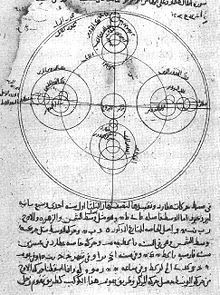 Ibn al-Shatir's model for the appearances of Mercury, showing the multiplication of epicycles using the Tusi-couple, thus eliminating the Ptolemaic eccentrics and equant.
Ibn al-Shatir's model for the appearances of Mercury, showing the multiplication of epicycles using the Tusi-couple, thus eliminating the Ptolemaic eccentrics and equant.
In ancient China, Mercury was known as Chen Xing (辰星), the Hour Star. It was associated with the direction north and the phase of water in the Wu Xing.[99] Modern Chinese, Korean, Japanese and Vietnamese cultures refer to the planet literally as the “water star” (水星), based on the Five elements.[100] Hindu mythology used the name Budha for Mercury, and this god was thought to preside over Wednesday.[101] The god Odin (or Woden) of Germanic paganism was associated with the planet Mercury and Wednesday.[102] The Maya may have represented Mercury as an owl (or possibly four owls; two for the morning aspect and two for the evening) that served as a messenger to the underworld.[103]
In ancient Indian astronomy, the Surya Siddhanta, an Indian astronomical text of the 5th century, estimates the diameter of Mercury as 3,008 miles, an error of less than 1% from the currently accepted diameter of 3,032 miles. This estimate was based upon an inaccurate guess of the planet's angular diameter as 3.0 arcminutes.
In medieval Islamic astronomy, the Andalusian astronomer Abū Ishāq Ibrāhīm al-Zarqālī in the 11th century described the deferent of Mercury's geocentric orbit as being oval, like an egg or a pignon, although this insight did not influence his astronomical theory or his astronomical calculations.[104][105] In the 12th century, Ibn Bajjah observed "two planets as black spots on the face of the Sun," which was later suggested as the transit of Mercury and/or Venus by the Maragha astronomer Qotb al-Din Shirazi in the 13th century.[106] (Note that most such medieval reports of transits were later taken as observations of sunspots.[107])
In India, the Kerala school astronomer Nilakantha Somayaji in the 15th century developed a partially heliocentric planetary model in which Mercury orbits the Sun, which in turn orbits the Earth, similar to the Tychonic system later proposed by Tycho Brahe in the late 16th century.[108]
Ground-based telescopic research
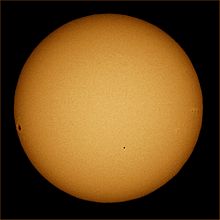 Transit of Mercury. Mercury is the small dot in the lower center, in front of the Sun. The dark area on the left of the solar disk is a sunspot.
Transit of Mercury. Mercury is the small dot in the lower center, in front of the Sun. The dark area on the left of the solar disk is a sunspot.
The first telescopic observations of Mercury were made by Galileo in the early 17th century. Although he observed phases when he looked at Venus, his telescope was not powerful enough to see the phases of Mercury. In 1631 Pierre Gassendi made the first telescopic observations of the transit of a planet across the Sun when he saw a transit of Mercury predicted by Johannes Kepler. In 1639 Giovanni Zupi used a telescope to discover that the planet had orbital phases similar to Venus and the Moon. The observation demonstrated conclusively that Mercury orbited around the Sun.[18]
A very rare event in astronomy is the passage of one planet in front of another (occultation), as seen from Earth. Mercury and Venus occult each other every few centuries, and the event of May 28, 1737 is the only one historically observed, having been seen by John Bevis at the Royal Greenwich Observatory.[109] The next occultation of Mercury by Venus will be on December 3, 2133.[110]
The difficulties inherent in observing Mercury mean that it has been far less studied than the other planets. In 1800 Johann Schröter made observations of surface features, claiming to have observed 20 km high mountains. Friedrich Bessel used Schröter's drawings to erroneously estimate the rotation period as 24 hours and an axial tilt of 70°.[111] In the 1880s Giovanni Schiaparelli mapped the planet more accurately, and suggested that Mercury’s rotational period was 88 days, the same as its orbital period due to tidal locking.[112] This phenomenon is known as synchronous rotation and is shown by Earth’s Moon. The effort to map the surface of Mercury was continued by Eugenios Antoniadi, who published a book in 1934 that included both maps and his own observations.[65] Many of the planet's surface features, particularly the albedo features, take their names from Antoniadi's map.[113]
In June 1962 Soviet scientists at the Institute of Radio-engineering and Electronics of the USSR Academy of Sciences led by Vladimir Kotelnikov became first to bounce radar signal off Mercury and receive it, starting radar observations of the planet.[114][115][116] Three years later radar observations by Americans Gordon Pettengill and R. Dyce using 300-meter Arecibo Observatory radio telescope in Puerto Rico showed conclusively that the planet’s rotational period was about 59 days.[117][118] The theory that Mercury’s rotation was synchronous had become widely held, and it was a surprise to astronomers when these radio observations were announced. If Mercury were tidally locked, its dark face would be extremely cold, but measurements of radio emission revealed that it was much hotter than expected. Astronomers were reluctant to drop the synchronous rotation theory and proposed alternative mechanisms such as powerful heat-distributing winds to explain the observations.[119]
Italian astronomer Giuseppe Colombo noted that the rotation value was about two-thirds of Mercury’s orbital period, and proposed that the planet’s orbital and rotational periods were locked into a 3:2 rather than a 1:1 resonance.[120] Data from Mariner 10 subsequently confirmed this view.[121] This means that Schiaparelli's and Antoniadi's maps were not "wrong". Instead, the astronomers saw the same features during every second orbit and recorded them, but disregarded those seen in the meantime, when Mercury's other face was toward the Sun, since the orbital geometry meant that these observations were made under poor viewing conditions.[111]
Ground-based optical observations did not shed much further light on the innermost planet, but radio astronomers using interferometery at microwave wavelengths, a technique that enables removal of the solar radiation, were able to discern physical and chemical characteristics of the subsurface layers to a depth of several meters.[122][123] Not until the first space probe flew past Mercury did many of its most fundamental morphological properties become known. Moreover, recent technological advances have led to improved ground-based observations. In 2000, high-resolution lucky imaging observations were conducted by the Mount Wilson Observatory 1.5 meter Hale telescope. They provided the first views that resolved surface features on the parts of Mercury which were not imaged in the Mariner mission.[124] Later imaging has shown evidence of a huge double-ringed impact basin even larger than the Caloris Basin in the non-Mariner-imaged hemisphere. It has informally been dubbed the Skinakas Basin.[125] Most of the planet has been mapped by the Arecibo radar telescope, with 5 km resolution, including polar deposits in shadowed craters of what may be water ice.[126]
Research with space probes
Reaching Mercury from Earth poses significant technical challenges, since the planet orbits so much closer to the Sun than does the Earth. A Mercury-bound spacecraft launched from Earth must travel over 91 million kilometers into the Sun’s gravitational potential well. Mercury has an orbital speed of 48 km/s, while Earth’s orbital speed is 30 km/s. Thus the spacecraft must make a large change in velocity (delta-v) to enter a Hohmann transfer orbit that passes near Mercury, as compared to the delta-v required for other planetary missions.[127]
The potential energy liberated by moving down the Sun’s potential well becomes kinetic energy; requiring another large delta-v change to do anything other than rapidly pass by Mercury. To land safely or enter a stable orbit the spacecraft would rely entirely on rocket motors. Aerobraking is ruled out because the planet has very little atmosphere. A trip to Mercury requires more rocket fuel than that required to escape the Solar System completely. As a result, only two space probes have visited the planet so far.[128] A proposed alternative approach would use a solar sail to attain a Mercury-synchronous orbit around the Sun.[129]
Mariner 10
The first spacecraft to visit Mercury was NASA’s Mariner 10 (1974–75).[16] The spacecraft used the gravity of Venus to adjust its orbital velocity so that it could approach Mercury, making it both the first spacecraft to use this gravitational “slingshot” effect and the first NASA mission to visit multiple planets.[127] Mariner 10 provided the first close-up images of Mercury’s surface, which immediately showed its heavily cratered nature, and revealed many other types of geological features, such as the giant scarps which were later ascribed to the effect of the planet shrinking slightly as its iron core cools.[130] Unfortunately, due to the length of Mariner 10's orbital period, the same face of the planet was lit at each of Mariner 10’s close approaches. This made observation of both sides of the planet impossible,[131] and resulted in the mapping of less than 45% of the planet’s surface.[132]
On March 27, 1974, two days before its first flyby of Mercury, Mariner 10's instruments began registering large amounts of unexpected ultraviolet radiation near Mercury. This led to the tentative identification of Mercury's moon. Shortly afterward, the source of the excess UV was identified as the star 31 Crateris, and Mercury's moon passed into astronomy's history books as a footnote.
The spacecraft made three close approaches to Mercury, the closest of which took it to within 327 km of the surface.[133] At the first close approach, instruments detected a magnetic field, to the great surprise of planetary geologists—Mercury’s rotation was expected to be much too slow to generate a significant dynamo effect. The second close approach was primarily used for imaging, but at the third approach, extensive magnetic data were obtained. The data revealed that the planet’s magnetic field is much like the Earth’s, which deflects the solar wind around the planet. The origin of Mercury’s magnetic field is still the subject of several competing theories.[134]
On March 24, 1975, just eight days after its final close approach, Mariner 10 ran out of fuel. Since its orbit could no longer be accurately controlled, mission controllers instructed the probe to shut down.[135] Mariner 10 is thought to be still orbiting the Sun, passing close to Mercury every few months.[136]
MESSENGER
A second NASA mission to Mercury, named MESSENGER (MErcury Surface, Space ENvironment, GEochemistry, and Ranging), was launched on August 3, 2004, from the Cape Canaveral Air Force Station aboard a Boeing Delta 2 rocket. It made a fly-by of the Earth in August 2005, and of Venus in October 2006 and June 2007 to place it onto the correct trajectory to reach an orbit around Mercury.[137] A first fly-by of Mercury occurred on January 14, 2008, a second on October 6, 2008,[138] and a third on September 29, 2009.[139] Most of the hemisphere not imaged by Mariner 10 has been mapped during these fly-bys. The probe successfully entered an elliptical orbit around the planet on March 18, 2011. The first orbital image of Mercury was obtained on March 29, 2011. The nominal mapping mission is one terrestrial year.[138]
The mission is designed to clear up six key issues: Mercury’s high density, its geological history, the nature of its magnetic field, the structure of its core, whether it has ice at its poles, and where its tenuous atmosphere comes from. To this end, the probe is carrying imaging devices which will gather much higher resolution images of much more of the planet than Mariner 10, assorted spectrometers to determine abundances of elements in the crust, and magnetometers and devices to measure velocities of charged particles. Detailed measurements of tiny changes in the probe’s velocity as it orbits will be used to infer details of the planet’s interior structure.[30]
BepiColombo
The European Space Agency is planning a joint mission with Japan called BepiColombo, which will orbit Mercury with two probes: one to map the planet and the other to study its magnetosphere.[140] Once launched, the spacecraft bus is expected to reach Mercury in 2019.[141] The bus will release a magnetometer probe into an elliptical orbit, then chemical rockets will fire to deposit the mapper probe into a circular orbit. Both probes will operate for a terrestrial year.[140] The mapper probe will carry an array of spectrometers similar to those on MESSENGER, and will study the planet at many different wavelengths including infrared, ultraviolet, X-ray and gamma ray.[142]
In culture
In Western astrology, Mercury is the ruling planet of Gemini and Virgo. That is, the supposed astrological influence of the planet was greatest when it was observed in these constellations.[143]
On maps of Mercury created by astronomers before the detailed mapping of recent decades, the Solitudo Hermae Trismegisti (Wilderness of Hermes Trismegistus) was identified as a major feature of the planet Mercury, covering about one-fourth of the planet in the SE quadrant.[144]
Mercury, the Winged Messenger, is a movement in Gustav Holst's The Planets.
See also
- Mercury in astrology
- Mercury in fiction
- Mariner 10 space probe to Mercury
- Colonization of Mercury
- Exploration of Mercury
Notes
- ^ Pluto was once considered the smallest planet, but as of 2006 it is classified as a dwarf planet.
- ^ Some sources precede the cuneiform transcription with "MUL". "MUL" is a cuneiform sign that was used in the Sumerian language to designate a star or planet, but it is not considered part of the actual name. The "4" is a reference number in the Sumero-Akkadian transliteration system to designate which of several syllables a certain cuneiform sign is most likely designating.
References
- ^ "mercurial". Merriam-Webster Online. http://www.merriam-webster.com/dictionary/mercurial. Retrieved 2008-06-12.
- ^ Yeomans, Donald K. (April 7, 2008). "HORIZONS System". NASA JPL. http://ssd.jpl.nasa.gov/?horizons. Retrieved 2008-04-07.
- ^ a b c d e f g h i j k l m "Mercury Fact Sheet". NASA Goddard Space Flight Center. November 30, 2007. http://nssdc.gsfc.nasa.gov/planetary/factsheet/mercuryfact.html. Retrieved 2008-05-28.
- ^ "The MeanPlane (Invariable plane) of the Solar System passing through the barycenter". 2009-04-03. http://home.comcast.net/~kpheider/MeanPlane.gif. Retrieved 2009-04-03. (produced with Solex 10 written by Aldo Vitagliano; see also Invariable plane)
- ^ a b c d e f g h Munsell, Kirk; Smith, Harman; Harvey, Samantha (May 28, 2009). "Mercury: Facts & Figures". Solar System Exploration. NASA. http://solarsystem.nasa.gov/planets/profile.cfm?Object=Mercury&Display=Facts. Retrieved 2008-04-07.
- ^ a b Seidelmann, P. Kenneth; Archinal, B. A.; A’hearn, M. F.; et al. (2007). "Report of the IAU/IAGWorking Group on cartographic coordinates and rotational elements: 2006". Celestial Mechanics and Dynamical Astronomy 90 (3): 155–180. Bibcode 2007CeMDA..98..155S. doi:10.1007/s10569-007-9072-y. http://adsabs.harvard.edu/doi/10.1007/s10569-007-9072-y. Retrieved 2007-08-28.
- ^ a b c Margot, L.J.; Peale, S. J.; Jurgens, R. F.; Slade, M. A.; Holin, I. V. (2007). "Large Longitude Libration of Mercury Reveals a Molten Core". Science 316 (5825): 710–714. Bibcode 2007Sci...316..710M. doi:10.1126/science.1140514. PMID 17478713.
- ^ a b Mallama, A.; Wang, D.; Howard, R.A. (2002). "Photometry of Mercury from SOHO/LASCO and Earth". Icarus 155 (2): 253–264. Bibcode 2002Icar..155..253M. doi:10.1006/icar.2001.6723.
- ^ a b c d e Mallama, A. (2011). "Planetary magnitudes". Sky and Telescope 121(1): 51–56.
- ^ a b Espenak, Fred (July 25, 1996). "Twelve Year Planetary Ephemeris: 1995–2006". NASA Reference Publication 1349. NASA. http://eclipse.gsfc.nasa.gov/TYPE/mercury2.html. Retrieved 2008-05-23.
- ^ Wudka, Jose (1998-09-24). "Precession of the perihelion of Mercury". Physics 7: Relativity and Cosmology. Department of Physics & Astronomy, University of California, Riverside. http://physics.ucr.edu/~wudka/Physics7/Notes_www/node98.html. Retrieved 2010-08-09.
- ^ Paul E. Alers (March 17, 2011). "Celebrating Mercury Orbit". NASA Multimedia. http://www.nasa.gov/multimedia/imagegallery/image_feature_1897.html. Retrieved 2011-03-18.
- ^ "NASA spacecraft now circling Mercury — a first". MSNBC. Mar 17, 2011. http://www.msnbc.msn.com/id/42142053/ns/technology_and_science-space/t/nasa-spacecraft-now-circling-mercury-first/. Retrieved 2011-03-24.
- ^ Russell, C. T.; Luhmann, J. G. (1997). "Mercury: Magnetic Field and Magnetosphere". Space Physics Center, UCLA Institute of Geophysics and Planetary Physics. http://www-spc.igpp.ucla.edu/personnel/russell/papers/merc_mag/. Retrieved 2007-03-16.
- ^ "Background Science". BepiColombo. European Space Agency. August 6, 2010. http://sci.esa.int/science-e/www/object/index.cfm?fobjectid=47055. Retrieved 2010-08-06.
- ^ a b c Dunne, J. A. and Burgess, E. (1978). "Chapter One". The Voyage of Mariner 10 — Mission to Venus and Mercury. NASA History Office. http://history.nasa.gov/SP-424/ch1.htm.
- ^ Duncan, John Charles (1946). Astronomy: A Textbook. Harper & Brothers. p. 125. "The symbol for Mercury represents the Caduceus, a wand with two serpents twined around it, which was carried by the messenger of the gods."
- ^ a b c d e f g h Strom, Robert G.; Sprague, Ann L. (2003). Exploring Mercury: the iron planet. Springer. ISBN 1-85233-731-1.
- ^ staff (May 8, 2003). "Mercury". U.S. Geological Survey. http://astrogeology.usgs.gov/Projects/BrowseTheGeologicSolarSystem/MercuryBack.html. Retrieved 2006-11-26.
- ^ Lyttleton, R. A. (1969). "On the Internal Structures of Mercury and Venus". Astrophysics and Space Science 5 (1): 18. Bibcode 1969Ap&SS...5...18L. doi:10.1007/BF00653933.
- ^ Gold, Lauren (May 3, 2007). "Mercury has molten core, Cornell researcher shows". Chronicle Online (Cornell University). http://www.news.cornell.edu/stories/May07/margot.mercury.html. Retrieved 2008-05-12.
- ^ a b Finley, Dave (May 3, 2007). "Mercury's Core Molten, Radar Study Shows". National Radio Astronomy Observatory. http://www.nrao.edu/pr/2007/mercury/. Retrieved 2008-05-12.
- ^ Spohn, Tilman; Sohl, Frank; Wieczerkowski, Karin; Conzelmann, Vera (2001). "The interior structure of Mercury: what we know, what we expect from BepiColombo". Planetary and Space Science 49 (14–15): 1561–1570. Bibcode 2001P&SS...49.1561S. doi:10.1016/S0032-0633(01)00093-9.
- ^ Gallant, R. 1986. The National Geographic Picture Atlas of Our Universe. National Geographic Society, 2nd edition.
- ^ Anderson, J. D.; et al. (July 10, 1996). "Shape and Orientation of Mercury from Radar Ranging Data". Icarus (Academic press) 124 (2): 690–697. Bibcode 1996Icar..124..690A. doi:10.1006/icar.1996.0242.
- ^ Schenk, P.; Melosh, H. J.; (03/1994). "Lobate Thrust Scarps and the Thickness of Mercury’s Lithosphere". Abstracts of the 25th Lunar and Planetary Science Conference 1994: 1994LPI....25.1203S. Bibcode 1994LPI....25.1203S.
- ^ a b c d Benz, W.; Slattery, W. L.; Cameron, A. G. W. (1988). "Collisional stripping of Mercury’s mantle". Icarus 74 (3): 516–528. Bibcode 1988Icar...74..516B. doi:10.1016/0019-1035(88)90118-2.
- ^ a b Cameron, A. G. W. (1985). "The partial volatilization of Mercury". Icarus 64 (2): 285–294. Bibcode 1985Icar...64..285C. doi:10.1016/0019-1035(85)90091-0.
- ^ Weidenschilling, S. J. (1987). "Iron/silicate fractionation and the origin of Mercury". Icarus 35 (1): 99–111. Bibcode 1978Icar...35...99W. doi:10.1016/0019-1035(78)90064-7.
- ^ a b Grayzeck, Ed. "MESSENGER Web Site". Johns Hopkins University. http://messenger.jhuapl.edu/. Retrieved 2008-04-07.
- ^ "BepiColombo". ESA Science & Technology. European Space Agency. http://sci.esa.int/science-e/www/area/index.cfm?fareaid=30. Retrieved 2008-04-07.
- ^ Staff (February 28, 2008). "Scientists see Mercury in a new light". Science Daily. http://www.sciencedaily.com/releases/2008/02/080201093149.htm. Retrieved 2008-04-07.
- ^ "Categories for Naming Features on Planets and Satellites". Planetarynames.wr.usgs.gov. http://planetarynames.wr.usgs.gov/Page/Categories. Retrieved 2011-08-20.
- ^ Blue, Jennifer (April 11, 2008). "Gazetteer of Planetary Nomenclature". US Geological Survey. http://planetarynames.wr.usgs.gov/. Retrieved 2008-04-11.
- ^ a b Dunne, J. A. and Burgess, E. (1978). "Chapter Seven". The Voyage of Mariner 10 — Mission to Venus and Mercury. NASA History Office. http://history.nasa.gov/SP-424/ch7.htm. Retrieved 2008-05-28.
- ^ Strom, Robert (1979). "Mercury: a post-Mariner assessment". Space Science Reviews 24: 3–70. Bibcode 1979SSRv...24....3S. doi:10.1007/BF00221842.
- ^ Broadfoot, A. L.; S. Kumar, M. J. S. Belton, and M. B. McElroy (July 12, 1974). "Mercury's Atmosphere from Mariner 10: Preliminary Results". Science 185 (4146): 166–169. Bibcode 1974Sci...185..166B. doi:10.1126/science.185.4146.166. PMID 17810510.
- ^ Staff (August 5, 2003). "Mercury". U.S. Geological Survey. http://astrogeology.usgs.gov/Projects/BrowseTheGeologicSolarSystem/MercuryBack.html. Retrieved 2008-04-07.
- ^ Head, James W.; Solomon, Sean C. (1981). "Tectonic Evolution of the Terrestrial Planets". Science 213 (4503): 62–76. Bibcode 1981Sci...213...62H. doi:10.1126/science.213.4503.62. PMID 17741171.
- ^ Morris, Jefferson (November 10, 2008). "Laser Altimetry". Aviation Week & Space Technology 169 (18): 18. "Mercury's crust is more analogous to a marbled cake than a layered cake."
- ^ a b c d e f g Spudis, P. D. (2001). "The Geological History of Mercury". Workshop on Mercury: Space Environment, Surface, and Interior, Chicago: 100. Bibcode 2001mses.conf..100S.
- ^ Shiga, David (January 30, 2008). "Bizarre spider scar found on Mercury's surface". NewScientist.com news service. http://space.newscientist.com/article/dn13257-bizarre-spider-scar-found-on-mercurys-surface.html.
- ^ Schultz, Peter H.; Gault, Donald E. (1975). "Seismic effects from major basin formations on the moon and Mercury". Earth, Moon, and Planets 12 (2): 159–175. Bibcode 1975Moon...12..159S. doi:10.1007/BF00577875.
- ^ Wieczorek, Mark A.; Zuber, Maria T. (2001). "A Serenitatis origin for the Imbrian grooves and South Pole-Aitken thorium anomaly". Journal of Geophysical Research 106 (E11): 27853–27864. Bibcode 2001JGR...10627853W. doi:10.1029/2000JE001384. http://www.agu.org/pubs/crossref/2001/2000JE001384.shtml. Retrieved 2008-05-12.
- ^ Denevi, B. W.; Robinson, M. S. (2008). "Albedo of Immature Mercurian Crustal Materials: Evidence for the Presence of Ferrous Iron". Lunar and Planetary Science 39: 1750. Bibcode 2008LPI....39.1750D.
- ^ a b c Wagner, R. J.; Wolf, U.; Ivanov, B. A.; Neukum, G. (October 4–5, 2001). "Application of an Updated Impact Cratering Chronology Model to Mercury' s Time-Stratigraphic System". Workshop on Mercury: Space Environment, Surface, and Interior. Proceedings of a workshop held at The Field Museum.. Chicago, IL: Lunar and Planetary Science Institute. p. 106. Bibcode 2001mses.conf..106W.
- ^ Dzurisin, D. (October 10, 1978). "The tectonic and volcanic history of Mercury as inferred from studies of scarps, ridges, troughs, and other lineaments". Journal of Geophysical Research 83 (B10): 4883–4906. Bibcode 1978JGR....83.4883D. doi:10.1029/JB083iB10p04883.
- ^ Van Hoolst, Tim; Jacobs, Carla (2003). "Mercury’s tides and interior structure". Journal of Geophysical Research 108 (E11): 7. Bibcode 2003JGRE..108.5121V. doi:10.1029/2003JE002126.
- ^ Prockter, Louise (2005). Ice in the Solar System. Volume 26. Johns Hopkins APL Technical Digest. http://web.archive.org/web/20060911205118/http://www.jhuapl.edu/techdigest/td2602/Prockter.pdf. Retrieved 2009-07-27.
- ^ Lewis, John S. (2004). Physics and Chemistry of the Solar System (2nd ed.). Academic Press. p. 463. ISBN 0-12-446744-X.
- ^ Murdock, T. L.; Ney, E. P. (1970). "Mercury: The Dark-Side Temperature". Science 170 (3957): 535–537. Bibcode 1970Sci...170..535M. doi:10.1126/science.170.3957.535. PMID 17799708.
- ^ Lewis, John S. (2004). Physics and Chemistry of the Solar System. Academic Press. p. 461. ISBN 978-0-12-446744-6. http://books.google.com/?id=ERpMjmR1ErYC&pg=RA1-PA461. Retrieved 2008-06-03.
- ^ Ingersoll, Andrew P.; Svitek, Tomas; Murray, Bruce C. (1992). "Stability of polar frosts in spherical bowl-shaped craters on the moon, Mercury, and Mars". Icarus 100 (1): 40–47. Bibcode 1992Icar..100...40I. doi:10.1016/0019-1035(92)90016-Z.
- ^ Slade, M. A.; Butler, B. J.; Muhleman, D. O. (1992). "Mercury radar imaging — Evidence for polar ice". Science 258 (5082): 635–640. Bibcode 1992Sci...258..635S. doi:10.1126/science.258.5082.635. PMID 17748898.
- ^ Williams, David R. (June 2, 2005). "Ice on Mercury". NASA Goddard Space Flight Center. http://nssdc.gsfc.nasa.gov/planetary/ice/ice_mercury.html. Retrieved 2008-05-23.
- ^ a b c Rawlins, K; Moses, J. I.; Zahnle, K.J. (1995). "Exogenic Sources of Water for Mercury's Polar Ice". Bulletin of the American Astronomical Society 27: 1117. Bibcode 1995DPS....27.2112R.
- ^ Harmon, J. K.; Perillat, P. J.; Slade, M. A. (2001). "High-Resolution Radar Imaging of Mercury's North Pole". Icarus 149 (1): 1–15. Bibcode 2001Icar..149....1H. doi:10.1006/icar.2000.6544.
- ^ Domingue, Deborah L. et al. (2009). "Mercury's Atmosphere: A Surface-Bounded Exosphere". Space Science Reviews 131 (1–4): 161–186. Bibcode 2007SSRv..131..161D. doi:10.1007/s11214-007-9260-9.
- ^ Hunten, D. M.; Shemansky, D. E.; Morgan, T. H. (1988). "The Mercury atmosphere". Mercury. University of Arizona Press. ISBN 0-8165-1085-7. http://www.uapress.arizona.edu/onlinebks/Mercury/MercuryCh17.pdf. Retrieved 2009-05-18.
- ^ Lakdawalla, Emily (July 3, 2008). "MESSENGER Scientists 'Astonished' to Find Water in Mercury's Thin Atmosphere". http://www.planetary.org/news/2008/0703_MESSENGER_Scientists_Astonished_to.html. Retrieved 2009-05-18.
- ^ Zurbuchen, Thomas H. et al. (2008). "MESSENGER Observations of the Composition of Mercury’s Ionized Exosphere and Plasma Environment". Science 321 (5885): 90–92. Bibcode 2008Sci...321...90Z. doi:10.1126/science.1159314. PMID 18599777.
- ^ "Instrument Shows What Planet Mercury Is Made Of". University of Michigan. June 30, 2008. http://newswise.com/articles/view/542209/. Retrieved 2009-05-18.
- ^ Killen, Rosemary; Cremonese, Gabrielle; Lammer, Helmut et al. (2007). "Processes that Promote and Deplete the Exosphere of Mercury". Space Science Reviews 132 (2–4): 433–509. Bibcode 2007SSRv..132..433K. doi:10.1007/s11214-007-9232-0.
- ^ McClintock, William E.; Vervack Jr., Ronald J.; Bradley, E. Todd et al. (2009). "MESSENGER Observations of Mercury’s Exosphere: Detection of Magnesium and Distribution of Constituents". Science 324 (5927): 610–613. Bibcode 2009Sci...324..610M. doi:10.1126/science.1172525. PMID 19407195.
- ^ a b c d e Beatty, J. Kelly; Petersen, Carolyn Collins; Chaikin, Andrew (1999). The New Solar System. Cambridge University Press. ISBN 0-521-64587-5.
- ^ Seeds, Michael A. (2004). Astronomy: The Solar System and Beyond (4th ed.). Brooks Cole. ISBN 0-534-42111-3.
- ^ Williams, David R. (January 6, 2005). "Planetary Fact Sheets". NASA National Space Science Data Center. http://nssdc.gsfc.nasa.gov/planetary/planetfact.html. Retrieved 2006-08-10.
- ^ a b c Staff (January 30, 2008). "Mercury’s Internal Magnetic Field". NASA. http://messenger.jhuapl.edu/gallery/sciencePhotos/image.php?page=2&gallery_id=2&image_id=152. Retrieved 2008-04-07.
- ^ Gold, Lauren (May 3, 2007). "Mercury has molten core, Cornell researcher shows". Cornell University. http://www.news.cornell.edu/stories/May07/margot.mercury.html. Retrieved 2008-04-07.
- ^ Christensen, Ulrich R. (2006). "A deep dynamo generating Mercury's magnetic field". Nature 444 (7122): 1056–1058. Bibcode 2006Natur.444.1056C. doi:10.1038/nature05342. PMID 17183319.
- ^ Spohn, T.; Sohl, F.; Wieczerkowski, K.; Conzelmann, V. (2001). "The interior structure of Mercury: what we know, what we expect from BepiColombo". Planetary and Space Science 49 (14–15): 1561–1570. Bibcode 2001P&SS...49.1561S. doi:10.1016/S0032-0633(01)00093-9.
- ^ a b Steigerwald, Bill (June 2, 2009). "Magnetic Tornadoes Could Liberate Mercury's Tenuous Atmosphere". NASA Goddard Space Flight Center. http://www.nasa.gov/mission_pages/messenger/multimedia/magnetic_tornadoes.html. Retrieved 2009-07-18.
- ^ "Space Topics: Compare the Planets: Mercury, Venus, Earth, The Moon, and Mars". Planetary Society. http://www.planetary.org/explore/topics/compare_the_planets/terrestrial.html. Retrieved 2007-04-12.
- ^ Espenak, Fred (April 21, 2005). "Transits of Mercury". NASA/Goddard Space Flight Center. http://eclipse.gsfc.nasa.gov/transit/catalog/MercuryCatalog.html. Retrieved 2008-05-20.
- ^ Biswas, Sukumar (2000). Cosmic Perspectives in Space Physics. Astrophysics and Space Science Library. Springer. p. 176. ISBN 0-7923-5813-9.
- ^ Liu, Han-Shou; O'Keefe, John A. (1965). "Theory of Rotation for the Planet Mercury". Science 150 (3704): 1717. Bibcode 1965Sci...150.1717L. doi:10.1126/science.150.3704.1717. PMID 17768871.
- ^ Correia, Alexandre C.M; Laskar, Jacques (2009). "Mercury's capture into the 3/2 spin-orbit resonance including the effect of core-mantle friction". Icarus 201 (1): 1. arXiv:0901.1843. Bibcode 2009Icar..201....1C. doi:10.1016/j.icarus.2008.12.034.
- ^ Correia, Alexandre C. M.; Laskar, Jacques (2004). "Mercury’s capture into the 3/2 spin–orbit resonance as a result of its chaotic dynamics". Nature 429 (6994): 848–850. Bibcode 2004Natur.429..848C. doi:10.1038/nature02609. PMID 15215857.
- ^ Laskar, J.; Gastineau, M. (June 11, 2009). "Existence of collisional trajectories of Mercury, Mars and Venus with the Earth". Nature 459 (7248): 817–819. Bibcode 2009Natur.459..817L. doi:10.1038/nature08096. PMID 19516336.
- ^ U. Le Verrier (1859), (in French), "Lettre de M. Le Verrier à M. Faye sur la théorie de Mercure et sur le mouvement du périhélie de cette planète", Comptes rendus hebdomadaires des séances de l'Académie des sciences (Paris), vol. 49 (1859), pp. 379–383. (At p. 383 in the same volume Le Verrier's report is followed by another, from Faye, enthusiastically recommending to astronomers to search for a previously undetected intra-mercurial object.)
- ^ Baum, Richard; Sheehan, William (1997). In Search of Planet Vulcan, The Ghost in Newton's Clockwork Machine. New York: Plenum Press. ISBN 0-306-45567-6.
- ^ Clemence, G. M. (1947). "The Relativity Effect in Planetary Motions". Reviews of Modern Physics 19 (4): 361–364. Bibcode 1947RvMP...19..361C. doi:10.1103/RevModPhys.19.361.
- ^ Gilvarry, J. J. (1953). "Relativity Precession of the Asteroid Icarus". Physical Review 89 (5): 1046. Bibcode 1953PhRv...89.1046G. doi:10.1103/PhysRev.89.1046.
- ^ Anonymous. "6.2 Anomalous Precession". Reflections on Relativity. MathPages. http://www.mathpages.com/rr/s6-02/6-02.htm. Retrieved 2008-05-22.
- ^ "USGS Astrogeology: Rotation and pole position for the Sun and planets (IAU WGCCRE)". http://astrogeology.usgs.gov/Projects/WGCCRE/constants/iau2000_table1.html. Retrieved 22 October 2009.
- ^ Baumgardner, Jeffrey; Mendillo, Michael; Wilson, Jody K. (2000). "A Digital High-Definition Imaging System for Spectral Studies of Extended Planetary Atmospheres. I. Initial Results in White Light Showing Features on the Hemisphere of Mercury Unimaged by Mariner 10". The Astronomical Journal 119 (5): 2458–2464. Bibcode 2000AJ....119.2458B. doi:10.1086/301323.
- ^ John Walker. "Mercury Chaser's Calculator". Fourmilab Switzerland. http://www.fourmilab.ch/images/3planets/elongation.html. Retrieved 2008-05-29. (look at 1964 and 2013)
- ^ "Mercury Elongation and Distance". http://home.comcast.net/~kpheider/Mercury.txt. Retrieved 2008-05-30. —Numbers generated using the Solar System Dynamics Group, Horizons On-Line Ephemeris System
- ^ a b c Patrick Kelly, ed. (2007). Observer's Handbook 2007. Royal Astronomical Society of Canada. ISBN 0-9738109-3-9.
- ^ Mercury Closest Approaches to Earth generated with:
1. Solex 10 (Text Output file)
2. Gravity Simulator charts
3. JPL Horizons 1950–2200
(3 sources are provided to prevent {{Or|date=July 2011}} concerns and to support general long-term trends) - ^ Tunç Tezel (January 22, 2003). "Total Solar Eclipse of 2006 March 29". Department of Physics at Fizik Bolumu in Turkey. http://www.physics.metu.edu.tr/~aat/TSE2006/TSE2006.html. Retrieved 2008-05-24.
- ^ Espenak, Fred (1996). "NASA Reference Publication 1349; Venus: Twelve year planetary ephemeris, 1995–2006". Twelve Year Planetary Ephemeris Directory. NASA. http://sunearth.gsfc.nasa.gov/eclipse/TYPE/venus2.html. Retrieved 2008-05-24.
- ^ Schaefer, Bradley E. (2007). "The Latitude and Epoch for the Origin of the Astronomical Lore in Mul.Apin". American Astronomical Society Meeting 210, #42.05 (American Astronomical Society) 38: 157. Bibcode 2007AAS...210.4205S.
- ^ Hunger, Hermann; Pingree, David (1989). "MUL.APIN: An Astronomical Compendium in Cuneiform". Archiv für Orientforschung (Austria: Verlag Ferdinand Berger & Sohne Gesellschaft MBH) 24: 146.
- ^ Staff (2008). "MESSENGER: Mercury and Ancient Cultures". NASA JPL. http://btc.montana.edu/messenger/elusive_planet/ancient_cultures_2.php. Retrieved 2008-04-07.
- ^ H.G. Liddell and R. Scott; rev. H.S. Jones and R. McKenzie (1996). Greek–English Lexicon, with a Revised Supplement (9th ed.). Oxford: Clarendon Press. pp. 690 and 1646. ISBN 0-19-864226-1.
- ^ Antoniadi, Eugène Michel; Translated from French by Moore, Patrick (1974). The Planet Mercury. Shaldon, Devon: Keith Reid Ltd. pp. 9–11. ISBN 0-904094-02-2.
- ^ Goldstein, Bernard R. (1996), "The Pre-telescopic Treatment of the Phases and Apparent Size of Venus", Journal for the History of Astronomy: 1, Bibcode 1996JHA....27....1G
- ^ Kelley, David H.; Milone, E. F.; Aveni, Anthony F. (2004). Exploring Ancient Skies: An Encyclopedic Survey of Archaeoastronomy. Birkhäuser. ISBN 0-387-95310-8.
- ^ China: De Groot, Jan Jakob Maria (1912). Religion in China: universism. a key to the study of Taoism and Confucianism. 10. G. P. Putnam's Sons. p. 300. http://books.google.com/books?id=ZAaP7dyjCrAC&pg=PA300. Retrieved 2010-01-08.
Japan: Crump, Thomas (1992). The Japanese numbers game: the use and understanding of numbers in modern Japan. Routledge. pp. 39–40. ISBN 0415056098.
Korea: Hulbert, Homer Bezaleel (1909). The passing of Korea. Doubleday, Page & company. p. 426. http://books.google.com/books?id=fxwpAAAAYAAJ&pg=PA426. Retrieved 2010-01-08. - ^ Pujari, R.M.; Kolhe, Pradeep; Kumar, N. R. (2006). Pride of India: A Glimpse Into India's Scientific Heritage. Samskrita Bharati. ISBN 81-87276-27-4.
- ^ Bakich, Michael E. (2000). The Cambridge Planetary Handbook. Cambridge University Press. ISBN 0-521-63280-3.
- ^ Milbrath, Susan (1999). Star Gods of the Maya: Astronomy in Art, Folklore and Calendars. University of Texas Press. ISBN 0-292-75226-1.
- ^ Samsó, Julio; Mielgo, Honorino (1994). "Ibn al-Zarqālluh on Mercury". Journal for the History of Astronomy 25: 289–96 [292]. Bibcode 1994JHA....25..289S.
- ^ Hartner, Willy (1955). "The Mercury Horoscope of Marcantonio Michiel of Venice". Vistas in Astronomy 1: 84–138. Bibcode 1955VA......1...84H. doi:10.1016/0083-6656(55)90016-7. at pp. 118–122.
- ^ Ansari, S. M. Razaullah (2002). "History of oriental astronomy: proceedings of the joint discussion-17 at the 23rd General Assembly of the International Astronomical Union, organised by the Commission 41 (History of Astronomy), held in Kyoto, August 25–26, 1997". Springer. p. 137. ISBN 1402006578.
- ^ Goldstein, Bernard R. (1969). "Some Medieval Reports of Venus and Mercury Transits". Centaurus 14 (1): 49–59. Bibcode 1969Cent...14...49G. doi:10.1111/j.1600-0498.1969.tb00135.x.
- ^ Ramasubramanian, K.; Srinivas, M. S.; Sriram, M. S. (1994). "Modification of the Earlier Indian Planetary Theory by the Kerala Astronomers (c. 1500 AD) and the Implied Heliocentric Picture of Planetary Motion". Current Science 66: 784–790. http://www.physics.iitm.ac.in/~labs/amp/kerala-astronomy.pdf. Retrieved 2010-04-23.
- ^ Sinnott, RW; Meeus, J (1986). "John Bevis and a Rare Occultation". Sky and Telescope 72: 220. Bibcode 1986S&T....72..220S.
- ^ Ferris, Timothy (2003). Seeing in the Dark: How Amateur Astronomers. Simon and Schuster. ISBN 0-684-86580-7.
- ^ a b Colombo, G.; Shapiro, I. I. (11/1965). "The Rotation of the Planet Mercury". SAO Special Report #188R 188. Bibcode 1965SAOSR.188.....C.
- ^ Holden, E. S. (1890). "Announcement of the Discovery of the Rotation Period of Mercury [by Professor Schiaparelli]". Publications of the Astronomical Society of the Pacific 2 (7): 79. Bibcode 1890PASP....2...79H. doi:10.1086/120099.
- ^ Merton E. Davies, et al. (1978). "Surface Mapping". Atlas of Mercury. NASA Office of Space Sciences. http://history.nasa.gov/SP-423/surface.htm. Retrieved 2008-05-28.
- ^ Evans, J. V.; Brockelman, R. A.; Henry, J. C.; Hyde, G. M.; Kraft, L. G.; Reid, W. A.; Smith, W. W. (1965). "Radio Echo Observations of Venus and Mercury at 23 cm Wavelength". Astronomical Journal 70: 487–500. Bibcode 1965AJ.....70..486E. doi:10.1086/109772.
- ^ Moore, Patrick (2000). The Data Book of Astronomy. New York: CRC Press. p. 483. ISBN 0-7503-0620-3. http://books.google.com/books?q=kotelnikov+1962+mercury&btnG=Search+Books.
- ^ Butrica, Andrew J. (1996). "Chapter 5". To See the Unseen: A History of Planetary Radar Astronomy. NASA History Office, Washington D.C.. ISBN 0-16-048578-9. http://history.nasa.gov/SP-4218/ch5.htm.
- ^ Pettengill, G. H.; Dyce, R. B. (1965). "A Radar Determination of the Rotation of the Planet Mercury". Nature 206 (1240): 451–2. Bibcode 1965Natur.206Q1240P. doi:10.1038/2061240a0.
- ^ Mercury at Eric Weisstein's 'World of Astronomy'
- ^ Murray, Bruce C.; Burgess, Eric (1977). Flight to Mercury. Columbia University Press. ISBN 0-231-03996-4.
- ^ Colombo, G. (1965). "Rotational Period of the Planet Mercury". Nature 208 (5010): 575. Bibcode 1965Natur.208..575C. doi:10.1038/208575a0.
- ^ Davies, Merton E. et al. (1976). "Mariner 10 Mission and Spacecraft". SP-423 Atlas of Mercury. NASA JPL. http://history.nasa.gov/SP-423/mariner.htm. Retrieved 2008-04-07.
- ^ Golden, Leslie M., A Microwave Interferometric Study of the Subsurface of the Planet Mercury (1977). Ph.D Dissertation, University of California, Berkeley
- ^ Mitchell, David L. and De Pater, Imke, Microwave Imaging of Mercury’s Thermal Emission at Wavelengths from 0.3 to 20.5 cm (1994). Icarus, 110, 2–32
- ^ Dantowitz, R. F.; Teare, S. W.; Kozubal, M. J. (2000). "Ground-based High-Resolution Imaging of Mercury". Astronomical Journal 119 (4): 2455–2457. Bibcode 2000AJ....119.2455D. doi:10.1086/301328.
- ^ L. V. Ksanfomality (2006). "Earth-based optical imaging of Mercury". Advances in Space Research 38 (4): 594. Bibcode 2006AdSpR..38..594K. doi:10.1016/j.asr.2005.05.071.
- ^ Harmon, J. K. et al. (2007). "Mercury: Radar images of the equatorial and midlatitude zones". Icarus 187 (2): 374. Bibcode 2007Icar..187..374H. doi:10.1016/j.icarus.2006.09.026.
- ^ a b Dunne, J. A. and Burgess, E. (1978). "Chapter Four". The Voyage of Mariner 10 — Mission to Venus and Mercury. NASA History Office. http://history.nasa.gov/SP-424/ch4.htm. Retrieved 2008-05-28.
- ^ "Mercury". NASA Jet Propulsion Laboratory. May 5, 2008. http://solarsystem.jpl.nasa.gov/planets/profile.cfm?Object=Mercury&Display=OverviewLong. Retrieved 2008-05-29.
- ^ Leipold, M.; Seboldt, W.; Lingner, S.; Borg, E.; Herrmann, A.; Pabsch, A.; Wagner, O.; Bruckner, J. (1996). "Mercury sun-synchronous polar orbiter with a solar sail". Acta Astronautica 39 (1): 143–151. doi:10.1016/S0094-5765(96)00131-2.
- ^ Phillips, Tony (October 1976). "NASA 2006 Transit of Mercury". SP-423 Atlas of Mercury. NASA. http://www.nasa.gov/vision/universe/solarsystem/20oct_transitofmercury.html. Retrieved 2008-04-07.
- ^ "BepiColumbo – Background Science". European Space Agency. http://sci.esa.int/science-e/www/category/index.cfm?fcategoryid=4586. Retrieved 2008-05-30.
- ^ Tariq Malik (August 16, 2004). "MESSENGER to test theory of shrinking Mercury". USA Today. http://www.usatoday.com/tech/news/2004-08-16-mercury-may-shrink_x.htm. Retrieved 2008-05-23.
- ^ Merton E. Davies, et al. (1978). "Mariner 10 Mission and Spacecraft". Atlas of Mercury. NASA Office of Space Sciences. http://history.nasa.gov/SP-423/mariner.htm. Retrieved 2008-05-30.
- ^ Ness, Norman F. (1978). "Mercury – Magnetic field and interior". Space Science Reviews 21 (5): 527–553. Bibcode 1978SSRv...21..527N. doi:10.1007/BF00240907.
- ^ Dunne, J. A. and Burgess, E. (1978). "Chapter Eight". The Voyage of Mariner 10 — Mission to Venus and Mercury. NASA History Office. http://history.nasa.gov/SP-424/ch8.htm.
- ^ Grayzeck, Ed (April 2, 2008). "Mariner 10". NSSDC Master Catalog. NASA. http://nssdc.gsfc.nasa.gov/nmc/spacecraftDisplay.do?id=1973-085A. Retrieved 2008-04-07.
- ^ "MESSENGER Engine Burn Puts Spacecraft on Track for Venus". SpaceRef.com. 2005. http://www.spaceref.com/news/viewsr.html?pid=18956. Retrieved 2006-03-02.
- ^ a b "Countdown to MESSENGER's Closest Approach with Mercury". Johns Hopkins University Applied Physics Laboratory. January 14, 2008. http://messenger.jhuapl.edu/gallery/sciencePhotos/image.php?gallery_id=2&image_id=115. Retrieved 2008-05-30.
- ^ "MESSENGER Gains Critical Gravity Assist for Mercury Orbital Observations". MESSENGER Mission News. September 30, 2009. http://messenger.jhuapl.edu/news_room/details.php?id=136. Retrieved 2009-09-30.
- ^ a b "ESA gives go-ahead to build BepiColombo". European Space Agency. February 26, 2007. http://www.esa.int/esaSC/SEMC8XBE8YE_index_0.html. Retrieved 2008-05-29.
- ^ Fleming, Nic (January 18, 2008). "Star Trek-style ion engine to fuel Mercury craft". The Telegraph. http://www.telegraph.co.uk/earth/main.jhtml?view=DETAILS&grid=&xml=/earth/2008/01/18/scimerc118.xml. Retrieved 2008-05-23.[dead link]
- ^ "Objectives". European Space Agency. February 21, 2006. http://sci.esa.int/science-e/www/object/index.cfm?fobjectid=31350. Retrieved 2008-05-29.
- ^ Beck, Roger (2007). A Brief History of Ancient Astrology. Wiley-Blackwell. pp. 84–87. ISBN 1-4051-1074-0.
- ^ Davies, Merton E; et al. (October 1976). "Antoniadi's Map of Mercury". SP-423 Atlas of Mercury. NASA. http://history.nasa.gov/SP-423/p15a.htm. Retrieved 2010-08-09.
External links
Listen to this article (info/dl)
This audio file was created from a revision of Mercury (planet) dated 2008-01-16, and does not reflect subsequent edits to the article. (Audio help)More spoken articles Media related to Mercury (planet) at Wikimedia Commons
Media related to Mercury (planet) at Wikimedia Commons- Atlas of Mercury—NASA
- Gazeteer of Planetary Nomenclature – Mercury (USGS)
- SolarViews.com—Mercury
- Astronomy Cast: Mercury
- Geody Mercury World’s search engine that supports NASA World Wind, Celestia, and other applications.
- A Day On Mercury flash animation
- Mercury articles in Planetary Science Research Discoveries
- ‘BepiColombo’, ESA’s Mercury Mission
- ‘Messenger’, NASA’s Mercury Mission
The Solar System 
Mercury Observation 
Transits Exploration Properties Geology - Beagle Rupes
- Caloris Basin
- Discovery Rupes
- Rembrandt Basin
- Resolution Rupes
Other topics Categories:- Mercury (planet)
- Terrestrial planets
Wikimedia Foundation. 2010.

